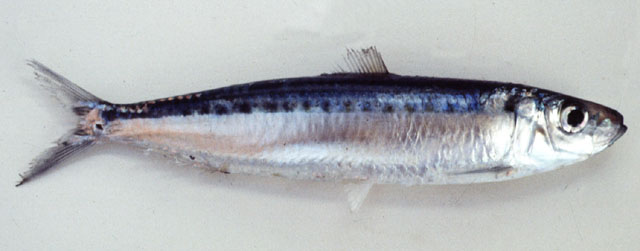| Dorosomatidae (Gizzard shads and sardinellas) |
| 27 cm SL (male/unsexed); max. reported age: 8 years |
|
reef-associated; brackish; marine; depth range 10 - 75 m |
| Indo-West Pacific: Red Sea and Mozambique to the Philippines, north to Taiwan and Okinawa (Japan), south to New Guinea, the Arafura Sea (Ref. 9819), northern Australia, and Fiji. |
|
Dorsal spines (total): 0-0; Dorsal soft rays (total): 13-21; Anal spines: 0-0; Anal soft rays: 12-23. Diagnosis: Body slender, belly rather rounded, scutes not prominent (Ref. 188). It is distinguished from Amblygaster clupeoides and A. leiogaster by the presence of a series of 10-20 gold, in life, or black, on preservation, spots down the flank, but sometimes missing; also, lower gillrakers 33-43, while 26-33 in the other two species (Ref. 188). Sardinops species are also round-bodied and have spots on the flanks, but possess bony radiating striae on the gill cover; round-bodied Sardinella species have one unbranched and 8 branched pelvic finrays while Amblygaster sirm has one unbranched and 7 branched pelvic finrays, and more than 100 gillrakers are present in Sardinella species, also no spots (Ref. 188). Last 2 anal-fin rays enlarged (Ref. 117228).
Description: Body slender, subcylindrical, belly rather rounded, with weak scutes (Ref. 188, 2871). More than 8 fronto-parietal striae (Ref. 2871). Pelvic fin with 1 unbranched and 7 branched rays (Ref. 188).
Colouration: Presence of a series of 10-20 golden-green, in life, or black, in preservation, spots down the flank, but sometimes missing (Ref. 188, 2871). |
| A pelagic, schooling species occurring in coastal waters and lagoons (Ref. 188, 53568), at depths of 1-75m (Ref. 82332). In Panggang Island, Indonesia it was recorded in temperatures of 28.5-29.8°C and salinities of 31.6-32.3 ppt (Ref. 823). It feeds mainly on copepods, nauplii and zoea larvae, larval bivalves and gastropods, as well as Peridinium and Ceratium; juveniles also on phytoplankton (Ref. 188). Used as bait in the tuna fishery. |
|
Least Concern (LC); Date assessed: 17 July 2017 Ref. (130435)
|
| harmless |
Source and more info: www.fishbase.org. For personal, classroom, and other internal use only. Not for publication.
